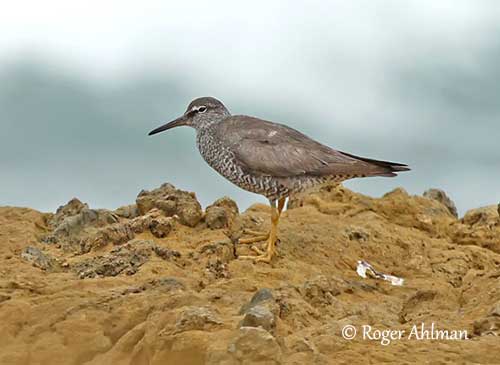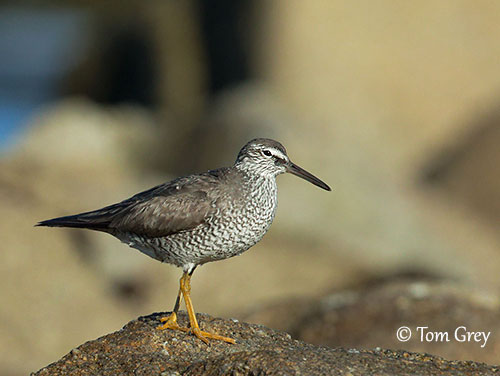
Fr: Chevalier errant
Ang: Wandering Tattler
All: Wanderwasserläufer
Esp: Playero de Alaska
Ita: Totano vagabondo
Nd: Amerikaanse Grijze Ruiter
Sd: amerikansk gråsnäppa
Photographers:
Roger Ahlman
Pbase Galleries Peru and Ecuador & My bird pictures on IBC
Tom Grey
Tom Grey's Bird Pictures & Tom Grey's Bird Pictures 2
Alan & Ann Tate
AA Bird Photography
Text by Nicole Bouglouan
Sources :
HANDBOOK OF THE BIRDS OF THE WORLD Vol 3 by Josep del Hoyo-Andrew Elliott-Jordi Sargatal - Lynx Edicions - ISBN: 8487334202
SHOREBIRDS by Peter Hayman, John Marchant and Tony Prater – Christopher Helm – 1986 – ISBN: 0747014035
GUIDE DES LIMICOLES de D. Taylor - Delachaux et Niestlé - ISBN : 2603014080
All About Birds (Cornell Lab of Ornithology)
The Birds of North America online
Wikipedia, the free encyclopaedia
Bird Web (Seattle Audubon Society)
What Bird-The ultimate Bird Guide (Mitchell Waite)
Wandering Tattler
Tringa incana
Charadriiformes Order – Scolopacidae family
INTRODUCTION:
The Wandering Tattler is an Alaskan breeder with wide oceanic migration. Many birds reach Australia while small numbers winter along the Pacific Coast of North America and the west Coast of South America.
This species feeds on insects, crustaceans and molluscs. It forages very actively over rocks in winter, and by walking and wading along mountain streams during the breeding season.
The Wandering Tattler is not globally threatened and the overall population trend is currently stable.

DESCRIPTION OF THE BIRD:
Biometrics:
Length: 26-29 cm
Wingspan: 54-55 cm
Weight: 120 g
The Wandering Tattler in breeding plumage has dark grey upperparts including crown, hindneck, wings and tail. Very narrow white tips are visible on uppertail-coverts, outer greater coverts and inner primary coverts.
The white underparts are strongly marked with V-shaped dark grey bars, except for a small white area in central belly and vent. Chin, throat, sides and foreneck are white with grey streaking. On the underwing, axillaries and underwing-coverts are dark grey with narrow white tips.
On the head, we can see a narrow white supercilium. Lores are blackish like the narrow eyestripe behind the eye. Ear-coverts, cheeks and rear of supercilium are white with grey streaking.
The bill (35-43mm) is dark grey, becoming yellowish at base. The eyes are dark brown, and surrounded above and below by two white crescents. Legs and feet are yellow.
Male and female have similar plumage, but the female is slightly larger than male.

The Wandering Tattler in non-breeding plumage lacks the dark barring on the underparts. Chin, throat, lower belly, vent and central undertail-coverts are whitish, whereas neck, breast and flanks are dark slate-grey.
On the head, the white supercilium is visible only in front of the eye, above the dark lores.
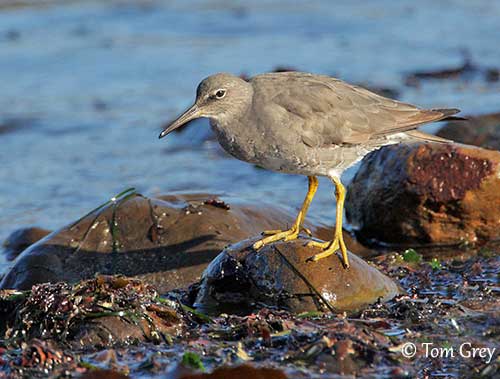
The juvenile resembles non-breeding adult. We can see indistinct pale fringes to scapulars, tertials and wing-coverts. The central rectrices show some whitish spotting along the edges.
RANGE:
The Wandering Tattler breeds in NE Siberia, Alaska and NW Canada.
It winters in SW USA, mainly S to California, and W Mexico to Galapagos Islands and Peru. It also occurs on Hawaiian Islands and on islands of C and S Pacific Ocean to E New Guinea and NE Australia.
HABITAT:
The Wandering Tattler frequents mostly exposed rocky coasts with reefs and rocky platforms, rather than mudflats, but it can be seen on pebbly beaches.
It breeds up to 1130 metres of elevation near mountain streams associated with dwarf shrub and montane tundra.
During winter and on migration, it frequents rocky coastlines, and occasionally forages in adjacent mudflats or on sandy beaches.
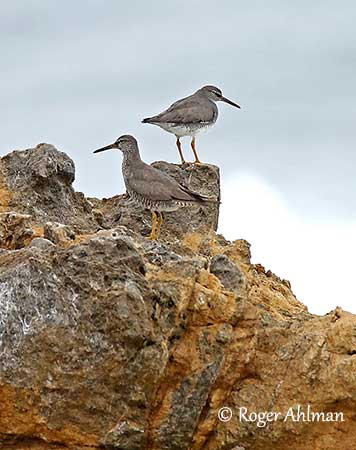
CALLS AND SONGS: SOUNDS BY XENO-CANTO
The Wandering Tattler in flight gives a series of 6-10 accelerating notes on the same pitch, described as plaintive, whistling, rippling trill “pew-tu-tu-tu-tu-tu”.
On the breeding grounds, the birds give loud piping calls “kree-kree-kree”. Both mates communicate with louder trills “tiri-tiri-tiri” also uttered during copulation and aggressive displays.
BEHAVIOUR IN THE WILD:
The Wandering Tattler usually feeds on insects (flies, beetles and caddisflies), crustaceans, amphipods and small molluscs.
However, during winter and on migration, the main food includes molluscs, marine worms, crabs, other crustaceans and other invertebrates.
It forages and feeds while bobbing and teetering almost continuously. It moves quickly among rocks and mounds of algae. It probes around rocks, often close to the breaking surf, and picks prey from water surface.
It is usually found alone or in small foraging groups. They form communal roosts at night.
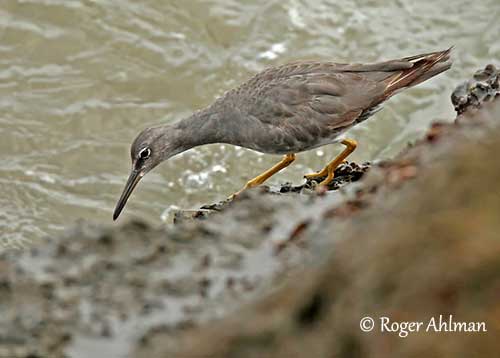
At the beginning of the breeding season, the Wandering Tattler male performs high flight displays over the nesting habitat, while uttering whistled song. It follows a long, straight path, sometimes extending well beyond the boundaries of the nesting territory.
They are seasonally monogamous, but some pairs may reform in several following seasons. This species nests on the ground and often near mountain streams.
The Wandering Tattler is a long-distance migrant, travelling from its northern breeding grounds to SW USA and NW South American coasts. Some birds cross the Pacific Ocean to reach Australia and South Pacific islands.
The flight is fast and easy, with rapid flicking beats of long wings. It can be seen flying low over the rocky coastline.
It is also a decent swimmer in spite of not webbed feet.
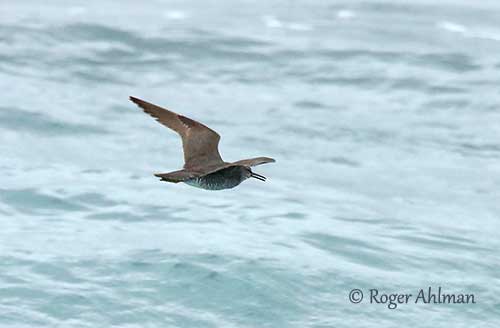
REPRODUCTION OF THIS SPECIES:
The Wandering Tattler is present on the breeding grounds from early May to August. It nests on the ground, among rocks or gravel, and often near mountain stream. The shallow depression may be lined (or not) with small twigs, rootlets and dry leaves. The same nest-site is often reused over several seasons.
The female lays 4 olive-green eggs with brown blotches. Both adults share the incubation during 23-25 days. The incubating adult often allows close approach while sitting motionless.
The chicks usually leave the nest soon after hatching, and both parents care them during 1-2 weeks. But later, only one adult is present. The young birds follow their parents along the water, and they are able to feed themselves. They can swim well too.
This species usually lays a single brood per season.
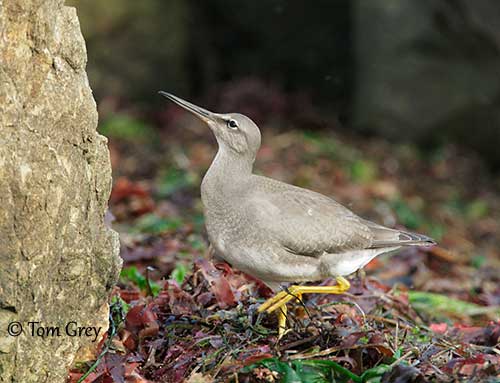
PROTECTION / THREATS / STATUS:
The Wandering Tattler is not globally threatened, and the population appears stable in spite of significant decrease in North America (-82,7% decline over 40 years), but more surveys are required in order to cover more extended range.
The global population is roughly estimated at 6,700/17,000 mature individuals.
The Wandering Tattler is currently evaluated as Least Concern.
